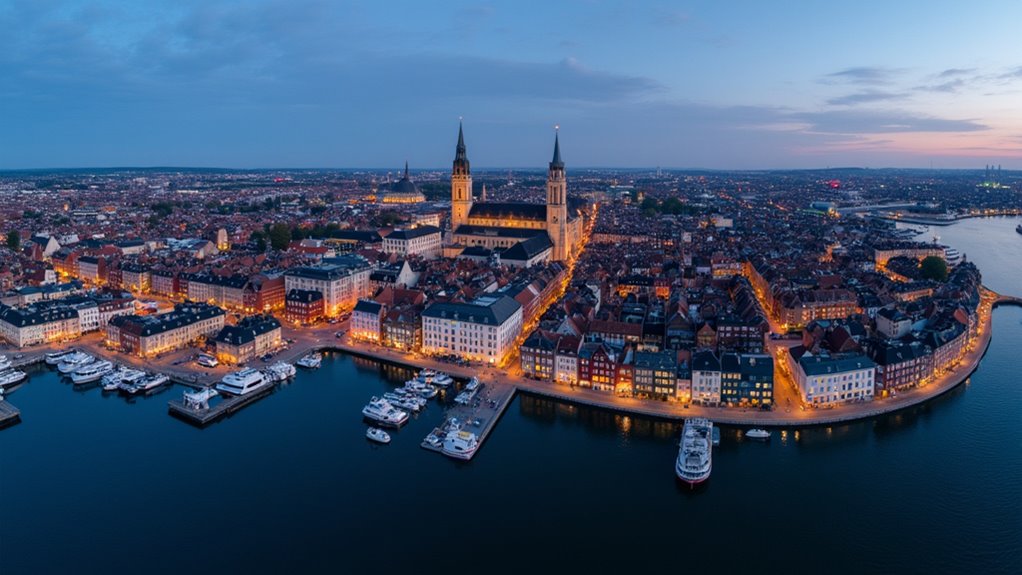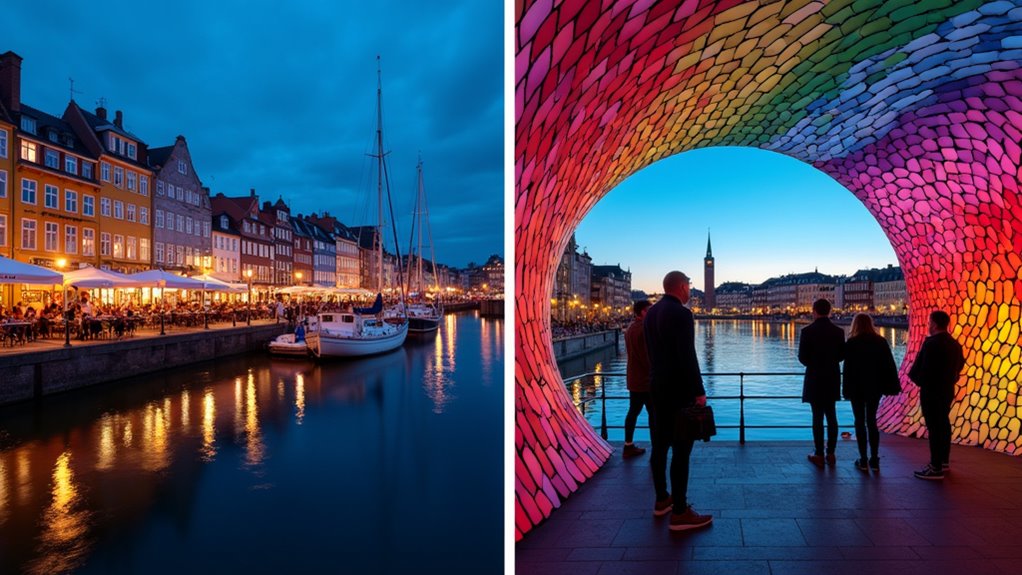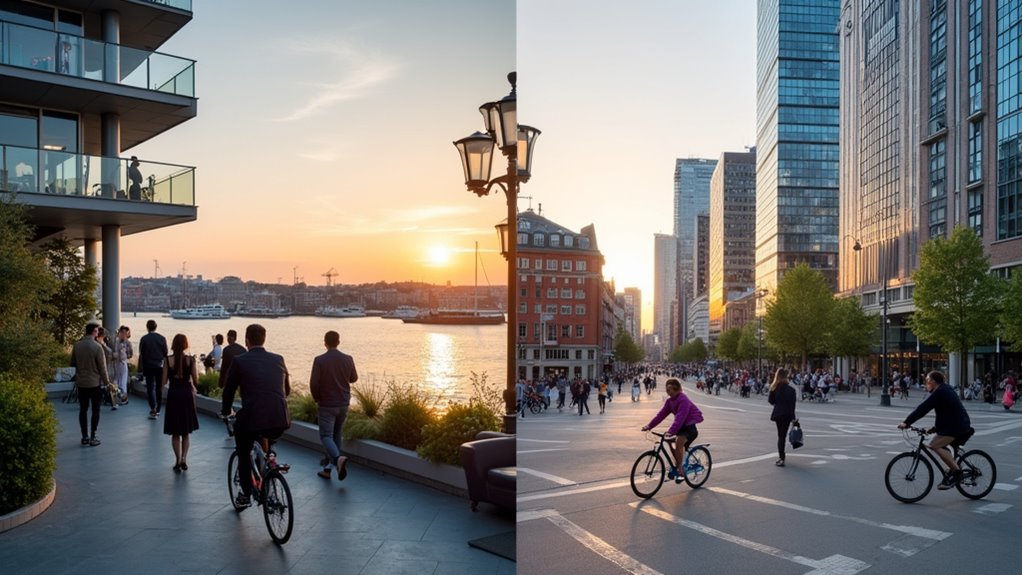Physical Address
304 North Cardinal St.
Dorchester Center, MA 02124
Physical Address
304 North Cardinal St.
Dorchester Center, MA 02124

Looking for your ideal Danish home? Copenhagen dazzles with cosmopolitan energy while Aarhus charms with community spirit.
Copenhagen and Aarhus offer distinctly different Danish experiences. As the capital, Copenhagen provides a cosmopolitan vibe with higher living costs, bustling nightlife, and extensive job markets. Aarhus, Denmark’s second-largest city, offers a more relaxed, community-focused lifestyle with lower housing prices and a thriving tech scene. Both cities feature excellent public transportation, world-class universities, and innovative green spaces. Your ideal choice depends on whether you prefer big-city energy or laid-back charm with strong community ties.

When comparing Denmark’s two most prominent urban centers, the contrast in size becomes immediately apparent. Copenhagen remains the undisputed heavyweight, with nearly 654,000 residents in the municipality alone and over 758,000 in the greater metropolitan area.
Aarhus, while notably smaller, isn’t exactly tiny. The urban area houses about 273,000 people, with the municipal region extending to around 362,000 residents. It’s part of the broader East Jutland metropolitan area that’s home to over 1.3 million Danes. Aarhus is known for hosting Scandinavia’s largest university, attracting students from across the region. Many travelers debate between exploring Danish cities or venturing to nearby Sweden when planning their Scandinavian itinerary.
You’ll notice Aarhus is growing quickly though, having added over 37,000 people recently—a 1.63% annual increase. Since 2006, when the population was just 229,000, the city has been steadily expanding and is projected to reach 306,000 by 2025.
While both cities offer high living standards typical of Denmark, your wallet will feel a noticeable difference between Copenhagen and Aarhus. The capital commands about 8% higher living costs overall, but housing shows the starkest contrast.
You’ll pay considerably more for accommodation in Copenhagen, with singles facing 7,500-11,000 DKK monthly versus Aarhus’s more modest 2,461-8,795 DKK. This pattern extends to food, transportation, and entertainment—all cheaper in Aarhus. Monthly public transportation passes cost significantly less in Aarhus, with residents saving nearly 46% on costs compared to Copenhagen commuters.
The housing market reflects this divide. Copenhagen’s high demand drives steep prices and frequent rent increases, while Aarhus offers more affordable options for both buyers and renters. Similar to how Denmark compares to Croatia’s Balkan prices, travelers and residents alike find significant cost variations between major cities.
Location matters in both cities, with central areas commanding premium prices regardless of which Danish city you choose.

Looking for cultural experiences? Both Danish cities deliver, but with different flavors. Copenhagen offers iconic institutions like the National Museum and the striking Black Diamond library, while hosting major events like Jazz Festival and Copenhagen Pride throughout the year.
Aarhus packs cultural punch with the renowned ARoS art museum and its rainbow panorama, plus the historical Old Town (Den Gamle By). The city’s vibrant university atmosphere fuels a lively canal-side nightlife scene. For couples seeking artistic inspiration, Aarhus provides romantic cultural settings similar to those found in popular European getaway destinations.
For entertainment, Copenhagen boasts the famous Tivoli Gardens combining amusement with cultural events, plus diverse nightlife options.
Meanwhile, Aarhus offers unique experiences at Godsbanen and Institut for X, where innovative cultural gatherings happen in repurposed spaces. The area behind Godsbanen showcases Aarhus’ cultural diversity with creative workshops and eateries. The Aarhus Festival and regular canal festivities keep the cultural calendar bustling year-round.
How do Copenhagen and Aarhus stack up academically? Both universities rank impressively globally, with Copenhagen slightly ahead (100th QS, 97th THE) compared to Aarhus (144th QS, 110th THE).
Copenhagen edges Aarhus in global rankings, though both Danish institutions hold impressive academic standing internationally.
You’ll find Copenhagen excels in traditional disciplines and medical studies, boasting Denmark’s largest medical faculty and multiple Nobel laureate connections. Meanwhile, Aarhus shines in interdisciplinary fields like environmental science and data analytics, offering 50+ English-taught programs with a problem-based learning approach.
For campus experience, Aarhus integrates green spaces with modern architecture, while Copenhagen blends urban historic and contemporary facilities. Aarhus University stands out for its citations per faculty, demonstrating its significant research influence in the academic world.
Both universities charge no tuition for EU/EEA students and maintain strong international diversity scores, though you’ll need competitive qualifications (IELTS 6.5+ for Aarhus) and strong GPA for popular programs. Like Zagreb, which hosts impressive educational institutions, both Danish cities offer vibrant student communities outside the classroom that enhance the academic experience.

Beyond academic excellence, your career prospects deserve careful consideration when choosing between Denmark’s two largest cities. Both Aarhus and Copenhagen offer robust tech sectors with competitive salaries ranging from 650K to 950K DKK annually.
Copenhagen boasts a diverse tech landscape with over 3,500 companies employing approximately 50,000 professionals, while Aarhus focuses on data science and IT services with approximately 1,500 firms. The tech industry is growing 8% faster than the European average in both cities, creating abundant opportunities. Like choosing between east or west destinations in Europe, your decision will impact the professional networks and industry specializations available to you.
You’ll find strong work-life balance in either location, with flexible hours and remote options. Both cities align with Denmark’s standard 37-hour workweek and comprehensive benefits packages including paid vacation and healthcare.
Learning Danish can boost your earnings by about 12%. Both cities host regular tech events for networking, and government initiatives like the Pay Limit Scheme make it easier for international professionals to establish careers.
When comparing transportation options between Denmark’s two largest cities, you’ll find robust networks that make traversing urban landscapes remarkably convenient. Copenhagen boasts the more extensive system with multiple metro lines complementing its buses, while Aarhus relies primarily on buses and trains.
Both cities offer excellent connectivity with tickets purchasable at stations or online—opt for digital booking for better rates. The three-hour train journey between Copenhagen and Aarhus provides scenic views and comfortable travel, with early bookers scoring discounted Orange tickets. Some bus routes include a delightful journey segment crossing by large comfortable catamarans.
For budget travelers, bus services like FlixBus connect the cities in about 3.5 hours, starting around $13. Much like European getaways in Spain and France, Denmark emphasizes efficient public transit as a cornerstone of the visitor experience.
English signage and real-time information make navigation straightforward for international visitors, while high accessibility standards ensure inclusive travel experiences across Denmark’s transportation networks.

Where Denmark’s urban planning truly shines is in its commitment to green spaces and environmental sustainability. Both Aarhus and Copenhagen integrate greenspaces that serve multiple functions beyond beauty – they’re critical infrastructure for climate adaptation, community building, and public health. The 1930s-40s innovative “Fingerplan” established protected green wedges and rings around Copenhagen that continue to shape the city’s development today.
Denmark’s cities reimagine greenspaces as multifunctional infrastructure—nurturing climate resilience, community bonds, and public wellbeing beyond mere aesthetics.
Copenhagen leverages its green identity more explicitly, using parks and gardens as part of its “liveable city” branding to attract travelers and businesses alike. Unlike coastal attractions such as Dubrovnik’s snorkeling spots, Copenhagen’s appeal lies in its thoughtful integration of nature within urban boundaries.
In both cities, you’ll experience:
While Aarhus follows similar Nordic trends, Copenhagen’s strategic green space planning is more extensively documented and marketed as part of its urban identity.
While both Copenhagen and Aarhus embrace green living, their daily rhythms reflect distinctly different urban personalities. You’ll notice Copenhagen’s cosmopolitan buzz with its faster work pace and international atmosphere, while Aarhus offers a more relaxed, community-focused lifestyle.
In the capital, you’ll find longer shopping hours and a diverse nightlife scene catering to its international residents. Copenhagen’s social calendar fills with large-scale festivals and events, though at premium prices—housing and dining will stretch your budget further than in Aarhus. With 87.44% of Danes living in urban areas, cities like Copenhagen showcase Denmark’s strong preference for city dwelling.
The second city compensates with its strong tech scene, cycling culture, and less congested streets. If work-life balance matters to you, Aarhus delivers a more laid-back atmosphere where community events take precedence over big-city hustle.
You’ve explored both Aarhus and Copenhagen—each with distinct benefits. While Copenhagen offers metropolitan energy and global connections, don’t dismiss Aarhus’s charm and lower costs. The “right” choice isn’t about which city ranks higher but which matches your priorities. Whether you crave lively thoroughfares or a more relaxed pace, Denmark’s two largest cities both deliver exceptional quality of life, just in different flavors.